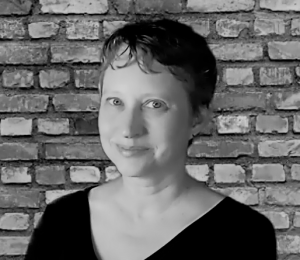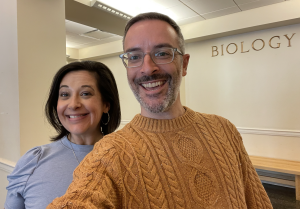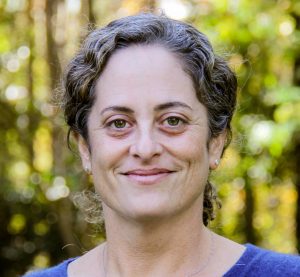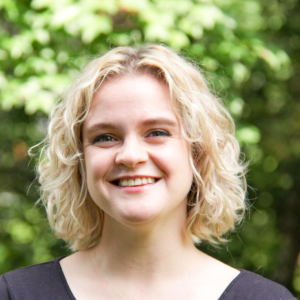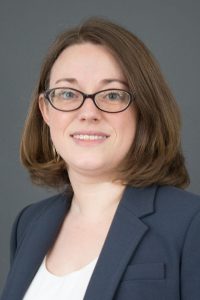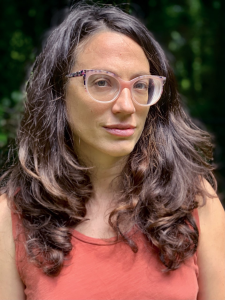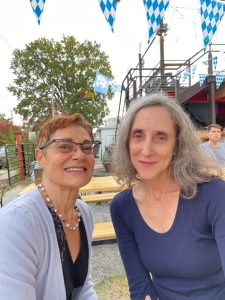CFE/Lenovo Instructional Innovation Grants

The Center for Faculty Excellence (CFE)/Lenovo Instructional Innovation Grants program empowers faculty members by providing funding to explore appropriate and effective uses of digital and instructional technologies to transform the educational experience for students at Carolina.
This year’s call for proposals focuses on support for generative artificial intelligence (AI). Generative AI has burst onto the scene over the past year and presents both opportunities and challenges as faculty, students, and academic units explore its impact on teaching and learning. This year’s CFE/Lenovo Instructional Innovation Grants Program will be used to support efforts to begin answering some of these questions.
2024-2025 Call for Proposals
- Three different grant categories for generative AI proposals (Curricular Development, Communities of Practice, and SoTL)
- Proposal due date has been extended to Monday, May 6, 2024, at 5pm.
Past Calls
2023-2024 Call for Proposals
The Center for Faculty Excellence (CFE)/ Lenovo Instructional Innovation Grants Program invites applications from faculty who seek to enhance teaching and learning by implementing instructional innovations at the University of North Carolina at Chapel Hill beginning in the 2023-2024 academic year.
Digital technologies continue to evolve, and with them opportunities to re-imagine nearly every aspect of teaching and learning. Proposals typically address factors where one might leverage instructional technologies, digital learning tools, or pedagogical approaches to enhance student learning and success. Prior projects have been developed in partnership with over 40 faculty across numerous departments and schools at Carolina, as well as various campus units or school-based professional staff (OASIS, ITS Educational Technologies, University Libraries, BeAM, IT staff in a UNCCH school). Descriptions and outcomes of previously funded projects are posted on the CFE website.
This grants program is designed to support faculty who want to explore teaching innovations using instructional technologies and pedagogical methods that engage and challenge students to learn, lower barriers to student access or success, or make their teaching more engaging, satisfying, evidence-based, and effective. We seek to support projects that have clear goals, demonstrable impact, appropriate timelines, and measurable outcomes that can serve as a model to other instructors or contribute to new knowledge related to effective teaching in higher education. Each project proposal must include a plan for a deliverable (research publication, conference or poster presentation, a campus workshop, participation in the CFE Faculty Showcase, or similar) showing how the project will contribute to teaching and/or learning.
Interest Areas
We invite proposals that enhance any aspect of teaching and learning with undergraduate, graduate, or professional students at Carolina. Projects related to data sciences, gaming (i.e., video gaming, board gaming, or other playful learning), pedagogy in the metaverse (e.g., AR, VR, XR) continue to be popular topics for accepted proposals. We encourage you to contact CFE staff listed at the bottom of this application to discuss any idea or topic which you think might merit consideration.
Funding
This year we invite proposals that align with one of two proposal types.
PI-led Core for Instructional Projects
The PI-led Core instructional project type can be funded up to $30,000 and based on the Selection Criteria listed below for an instructional innovation project. To be eligible each project application needs a faculty member who serves as the Primary Investigator (P.I.) to lead a project, to implement teaching and learning innovations in an instructional setting, and to conduct research to demonstrate the impact of the instructional innovation.
Seed funding for Team-based Instructional Projects
Seed funding for Team-based instructional projects, a new proposal type, can be funded up to $50,000 for proposals that bring together three or more faculty members in pursuit of a common instructional innovation project. Team-based projects may designate either a faculty member or a Carolina staff member in a campus unit (such as University Libraries) as the PI. If a staff member is indicated as the PI then at least one faculty member must be included and listed as a Co-PI. This seed funding may be applied to stipends for participating faculty members, hardware or software to be used for the instructional innovation, or to hire a graduate assistant or compensate a staff member for their role in helping to organize and facilitate the faculty team.
The purpose of this seed funding is to provide support to a faculty member or campus partner to organize and facilitate a group of faculty members to embark on a common instructional innovation project within their courses or across curricula. These courses could feature a common innovation to be applied across multiple departments or multiple sections of a single course. Team-based instructional projects must also conduct research to demonstrate the impact of the instructional innovation.
An example of such a project might be for faculty teaching different courses in related departments to collaborate in the development of a classroom space that makes use of rich media formats to facilitate instruction and in-class activities. Another example might be a group of three or more instructors teaching multiple sections of a large course within a department who implement an instructional innovation across sections and want to assess the impact on student learning.
Proposals for this seed funding must, as part of their application, provide clear descriptions of:
- What the seed grant will accomplish, with an emphasis on the instructional innovation(s) to be implemented across participating faculty.
- The target faculty you intend to work with (including what students they instruct) together with a plan for how you intend to recruit faculty members and engage them throughout the course of the project.
Background
The CFE/Lenovo Instructional Innovation Grants Program began as part of the Carolina Computing Initiative (CCI) that ensures Carolina students have easy access to high-quality and affordable technology. In 2017, Lenovo made a multi-year commitment to provide an annual rebate from CCI sales to support this grants program administered by the Center for Faculty Excellence. Since then, 42 projects have been funded across four funding cycles. Projects have supported classroom innovations, campus infrastructure, interdisciplinary projects, and AR/VR/XR or other emerging technologies in teaching. Please review the Prior Grant Awardees listed below. The CFE and partner organizations including ITS Educational Technologies, OASIS, and the University Libraries are excited to continue this Lenovo-supported grants program to support the work of faculty or instructors who are exploring new ways to educate, engage, and empower Carolina students in any school or program of study.
Program Goals
The goals of the grants program are to:
Empower faculty members and academic units to advance instructional innovation goals via applications of instructional technologies or digital tools,
Increase faculty awareness and instructional uses of digital solutions and/or emerging technologies to enhance teaching and learning at Carolina.
Eligibility
In 2023-24, there are two proposal types in which individuals or teams can submit proposals. For PI-led Core project proposals, faculty members teaching in any school or department at UNC-Chapel Hill are eligible to apply. They may name other faculty, staff, or students as Co-PIs who have various roles in the project. For the new Seed Funding for Team-based Projects, a campus staff member in a relevant unit can serve as the PI, but you must also identify at least one faculty member as a Co-PI. Students (graduate or undergraduate) can be named as collaborators on team proposals.
In either proposal type, UNCCH staff members may also be listed as Co-PIs or affiliated staff. The person identified as the Principal Investigator (PI) cannot be funded as a PI or Co-PI on more than one proposal for the current year’s grant cycle.
Supported Activities
Grants can be used to enhance any form of instruction or learning at UNCCH. Proposals do not have to be linked to a credit-bearing course. Applicants have broad discretion to consider a wide range of instructional or learning goals that technology can support. We encourage applicants to review the summaries of previously funded CFE/Lenovo projects for examples of how their proposals might build upon existing campus resources or infrastructure or how they might address unique instructional innovations.
A strong proposal will note how the project aligns with the strategic initiatives outlined in Carolina’s strategic plan, Carolina Next: Innovations for Public Good, the IDEAs in Action general education curriculum revision, the Quality Enhancement Plan, or school-based strategic plans or educational initiatives. Approved projects should be ready to begin planning in or before the Fall 2023 semester and implemented in courses by Spring 2024.
Role of Technology
The use of instructional technology or digital resources is a requirement for this program, but proposals are not limited to the use of specific technologies or current campus-supported tools.
For example, some proposals may feature newer technologies such as Augmented/Virtual/Extended Reality (AR/VR/XR), Artificial Intelligence/Machine Learning (AI/ML), or Internet of Things (IoT) that are not yet widespread on campus, while others may make innovative use within their department, program, or school of older technologies already present on campus. Prospective applicants are encouraged to familiarize themselves with campus-supported technologies already available.
Project Assessment, Program Evaluation, and Support
Every proposal must develop and include a plan for assessment of the impact on your project on teaching or on student learning, attitudes, growth, engagement, or success (with support from CFE or related partners), and a plan to disseminate your findings through a white paper, publication(s), and/or presentation(s).
The CFE can partner with each grant recipient to refine the plan for assessment and help with evaluation of project impacts. In addition, grant recipients are expected to provide brief quarterly reports to the CFE and to participate in basic evaluation activities of the overall grants program. If you plan to budget for assessment support within your academic unit or using another campus resource, please check with the CFE first to clarify how that support can complement CFE assessment activities.
Recipients may seek to adopt assessment or evaluation methodologies modeled on the Scholarship of Teaching and Learning (SoTL) in order to publish or present their findings via higher education or disciplinary teaching conferences or journals. Some may seek ways to contribute to departmental or cross-disciplinary workshops or to participate in the CFE Faculty Showcase on Teaching, or similar conferences beyond Carolina. Grant recipients should include acknowledgement of receiving support from the CFE/Lenovo Instructional Innovation Grants Program at UNCCH in any scholarly products. Staff from the CFE and relevant partner organizations (including ITS-Educational Technologies, OASIS, and University Libraries) often support grant recipients in these scholarly and research activities. Grant recipients may receive additional support by participating in one of several Faculty Learning Communities (FLCs) hosted by the CFE or other units that relate to innovative technologies used in their projects. Examples include the CFE SoTL FLC or the XR FLC managed by University Libraries.
Selection Criteria
Proposals will be reviewed using the following criteria (not listed in order of importance).
- Personal Commitment / Interest in proposal: brief personal statement of your personal interest, investment, and effort available to implement
- Proposed Instructional Innovation: Describe any pedagogical or classroom teaching innovations to be utilized; explain what is innovative about doing this in your discipline or course and how students will be engaged
- Alignment with Learning Goals: Identify and clearly articulate how the innovation will align with the stated learning goals and enhance student learning; as appropriate, note how universal design principles or matters of diversity, equity, or inclusive teaching inform the proposal or project
- Technology Role, Support and Sustainability: Explain the importance and role of any technology chosen to support project goals; Consider the shelf-life of any proposed technology innovation noting future updates and any ongoing costs, and consider ongoing leadership, administration, technology support, and partnerships or future funding that may support project longevity
- Impact: Describe the significance within a course or curriculum, the number of participants affected (# of students per semester), or any potential for use in instructional settings beyond UNCCH
- Implementation plan: Outline the project timeline and milestones. Funded projects should have a start date no later than during the Spring 2024 semester. We recognize that some larger projects might require two academic years to complete.
- Feasibility: Note how the proposal implementation can be completed within the stated timeframe using existing campus or technical resources or new support to be developed
- Relevance: Explain how the project builds upon existing or contributes to new, generalizable, knowledge or technologies related to teaching and learning
- Equity: Describe how the proposed instructional innovation takes into account equity in learning for students or addresses a current equity shortfall.
Budget Allowances
Applicants may request funding to cover costs directly related to their proposals including technology, training, faculty stipends, as well as staff and student salary support. The CFE will provide some assessment and evaluation support for each funded project. Funds for this program are not to be used to support travel, conference registrations, or other activities not directly related to the proposal implementation.
Proposal Submission Process
We respect every applicant’s time, and therefore encourage you to email the CFE contacts (belskie@unc.edu and doug.james@unc.edu) with any questions well in advance of your submission. The CFE contacts can clarify whether your project ideas fit within the scope of the program and whether the proposed technology can be properly supported.
To Apply
To submit your application, please select and download the appropriate CFE/Lenovo Application Template below. Follow the instructions on the template to submit via the provided link by the February 13, 2023 deadline.
- PI-led Core for instructional projects (link to application)
- Seed funding for Team-based instructional projects (link to application)
When completed the Application can be uploaded at https://go.unc.edu/CFELenovo.
Please see the CFE Lenovo 2023-24 Timeline below for deadlines and details.
CFE Lenovo 2023-24 Timeline
- Call for Proposals opens: December 7, 2022
- Recommended date to seek optional CFE input by: Friday, January 27, 2023
- Deadline for Full Proposal: Monday, February 13, 2023 5:00 PM (EST)
- Review Committee decisions announced: by March 10, 2023
- Funding released: (depends upon the funding amount)
In general, we plan to release the first half of approved funding around July 15, 2023 and the second half in January 2024. If funds are needed for summer effort, we can release them in May 2023. We will confirm departmental business contact information for those proposals accepted and approved for funding.
Contact Information
CFE staff members or colleagues from related units (ITS Educational Technologies, OASIS, University Libraries) involved in the CFE/Lenovo projects are available to discuss proposal ideas and respond to questions about the Call for Proposals.
Program Contact:
Matthew Belskie, CFE/OASIS (Office of Arts and Sciences Information Services) Liaison
or please contact:
Dr. Doug James, Associate Director for Faculty Development in Teaching and Learning, CFE (Center for Faculty Excellence)
2022-2023 Grant Awardees
Improving Social (Data) Science Undergraduate Training Through Technology and GamificationThis project develops new core course materials for POLI281 – Data in Politics I. POLI 281 introduces students to the fundamentals of quantitative data management, description, and analysis. While Poli281 has been a successful course, many students still struggle with the abstract nature of the skills, and with developing the strong foundation they need to use quantitative data in their own lives and careers. Our project will reorganize the course into set skill modules; develop a set of low-stakes evaluations to better gauge student progress and trouble-shoot areas of concern; and—most critically—create a new system of homework projects based on capture-the-flag-style computational challenges. Our goal is to improve data literacy for all students, regardless of backgrounds, and ensure that all UNC students have the tools they need to succeed in an increasingly data-driven world. |
PI: Lucy Martin, Political Science |
Prior Grant Awardees
This project set out to create flipped modules for teaching the Business Model Canvas. Following the “Own It, Learn It, Share It” framework for instructional design, each module begins with students “owning it” by constructing a connection with the topic and their idea for a venture. Next, student “learn it” by viewing a video that explains that topic, which is reinforced with a virtual reality experience that utilizes 360-degree videos. That experience is intended to demonstrate the topic in an authentic setting. For these modules, that setting is UNC. Finally, to “share it,” students make a presentation about the application of the topic to their venture via PitchVantage, a platform that uses artificial intelligence to provide students feedback about their presentation.
This project aims to develop Mandarin Talk, a Mobile app that visualizes pronunciation methods, tongue positions, and tone pitches of Chinese pronunciations. The target courses include two elementary level Mandarin Chinese curses: CHIN101 Elementary Chinese I, and CHIN 102 Elementary Chinese II. Mandarin Talk is designed to provide students high-quality practice with immediate feedback. With the assistance of technology, this app makes effective pronunciation demo and hands-on practices available to all students at no cost. It is hoped that this app will help teachers compensate for large class size, lack of teaching assistants, and possible continued remote teaching. With the help of technological innovation, this app can promote educational equity by providing under-staffed public university students with equally fine instruction on pronunciation without being disadvantaged by economic disparity.
In order to deliver high quality and safe patient care, all health care providers must be skilled in interprofessional communication and collaboration, problem solving, and critical thinking. Sloppy Mountain Medical Center is a team-skills-challenge activity modeled after the popular “escape room” activities, except that it is played entirely on-line. The theme of this activity is grounded in interprofessional health care delivery and takes place in a simulated hospital setting.
Using the Lenovo grant, I redesigned the N352 (Pathophysiology and Pharmacology Part II) with 2D illustrations and animations. I implemented this in Fall 2021 and currently working on to apply for IRB application to survey students
The 3-year sequence of medical device design classes are a core requirement of the biomedical engineering undergraduate program. These classes teach students the principles of medical device design from the initial stages of problem identification through to development of a solution prototype. As part of these classes, students currently learn a range of technical skills such as computer-aided design and rapid prototyping which they use in their senior year class to design and build a medical device to solve a healthcare problem. The purpose of this project is to introduce VR technologies to students in the program so that they can use them as tools for prototyping their device designs and for communicating their concept ideas to their clinical mentors. Developing skills to use VR in engineering design will complement the students’ other design tools and enable them to be at the forefront of this emerging field. The aims of the project are to teach BME students how to create a virtual environment simulating the healthcare setting in which their device will be used. They will then import their medical device CAD model into the environment and interact with it to assess need qualities such as user interface, aesthetics, ergonomics, mobility, and, where possible, functionality. Students will be able to invite clinical partners to take part in user feedback sessions and design reviews in the VR environment. The design communication opportunities afforded by using VR will allow for much improved clinician or patient feedback prior to physical prototypes being created. Ultimately this should enable more user-focused device designs being developed to solve unmet healthcare needs.
The goal of this project was to make high quality recordings of lectures, and to streamline the process enough that other tenured faculty would be willing to do the same. This was motivated by students needing to stay home if sick, as well as allowing students access to lectures (edited and with captions) to watch again. I hired an undergraduate to edit the videos and captions, which was essential to the process. In the spring semester, I am teaching a small graduate course and will experiment more with the in room technology in the smaller rooms.
We are focused on expanding immersive learning in the UNC School of Medicine curriculum, in collaboration with numerous faculty providers and students across our departments, including current requests for the Neurosciences block (Part of MTEC103 course) to integrate longitudinally with Social Health Sciences Curriculum and Patient Centered Care Course, Radiation Oncology, Orthopedic Surgery, and the Surgery Clerkship Curriculum, Neurosciences Bootcamp (Part of Transition to Residency Course).
While our goal to expand immersive learning in SOM curriculum spans a variety of use-cases, our initial use case is focused on improving empathy and understanding for the patient perspective, to improve patient-centered care in collaboration with our Trauma Services team.
In our first semester running the course, we conducted it remotely. Students reported a very positive experience that enhanced their scientific skill set. Due to the remote nature of the course, students voiced their desire for a more hands-on experience, noting the limited computational power of their laptops to process image analysis jobs and the challenge associated with 3-D visualization of a biological macromolecular mechanism (e.g. protein structural changes and the process of lipid droplet biogenesis).
In this course, and through this proposal, we aim to further develop Biol544L, capitalizing on our familiarity with big data microscopy image analysis software that the class will use to analyze image data without bias. We will also capitalize on our expertise in structural biology, and have the class utilize molecular graphics visualization programs to generate models of the macromolecules they investigate and print 3-D flexible models of their system using the BeAM Maker Space to help visualize the process and to aid in presenting their findings to the public.
Thus, we are excited to enhance the class with cutting edge computational tools for data processing, analysis, and visualization, and empower our students with competencies in these areas.
Registered Dietitians are increasingly being hired to manage foodservice programs in hospitals, corporate dining rooms, college and university campuses, school cafeterias, sports and entertainment arenas, and other public and private venues. In addition, they are taking on leadership roles in environments that require knowledge of wellness trends and programming, education of colleagues and staff, education of the public, agricultural and foodservice sustainability trends, government regulation, food labeling, recipe and menu development with chefs, product development, quality assurance, etc.
Foodservice management is required subject matter for all students studying to become Registered Dietitians (RDs). Approximately 4800 students across the US each year take the exam to become an RD—an exam in which 35% of the content is based on Food Systems and Management of Food and Nutrition Programs and Services. At UNC, the RD curriculum does not afford time to teach this content, so this material—which comprises over ⅓ of the registration/licensure exam—must be learned as a part of a two-week field experience. In addition to preparation for the RD exam, this Foodservice Management Experience provides students with the skills and confidence necessary to perform at entry level in a foodservice management setting; the perspective to choose areas of interest and expertise for those interested in foodservice management careers; and the opportunity to achieve required competency measures established by the Accreditation Council for Education in Nutrition and Dietetics (ACEND®).
This project focuses on makerspace faculty development programming within the BeAM Network of Makerspaces at UNC-Chapel Hill. In particular, project leaders will use insights gained from moving courses to hybrid models over the past pandemic year to train faculty in the design and development of flexible, blended makerspace curriculum that deeply connects to their course content. This past year posed challenges for faculty across campus, but makerspace courses faced a particularly unique dilemma: how do you provide hands-on design and making experiences during a global pandemic? How do you design maker course curricula that can adapt for either remote, blended, or in-person learning, while still consistently meeting the same course objectives across all learning modes?
Results: Project completed. Endeavors Magazine covered the project in their presentation Here
(“Taking Research to New Heights.”) UNC’s The Well also covered their progress Here.
Results: Project completed. Development and piloting were completed on modules for Orientation (in person and online in Sakai), the 3D Printer, and Laser Cutter. Given the shift to remote teaching, they also added online modules and digital learning approaches.
Results: Despite the pandemic, Sabrina Robertson has been able to incorporate the ELNs in a neuroscience wet-lab course (Spring 2020); and several of her students in Spring 2020 presented research posters on their lab findings virtually at the UNC Annual Celebration of Undergraduate Research.
Results: Project planning and resources were completed, but course disrupted due to the pandemic and shift to remote teaching. A collaboration with Duke on the project has advanced with Michael Betts who has pressed forward with IRB reviews of assessment of student outcomes. A systematic study is ongoing of the impact of this interactive teaching module on student engagement and student learning.
Results: Given that their project is web-based, it was possible to meet the need for more online learning as clinical rotations in the school of medicine were paused. To address the challenge of creating accurate rosters of students moving from their 3rd to 4th years between 2 courses where the web-based modules are embedded, they have embedded these modules entirely in the 3rd year course.
Results: Most recent updates include the creation of more than 70 models in 3D of their fossil cast collection along with progress on a set of “teaching modules” built around this collection. Completed models can been seen Here. The medical side of the project has shifted towards virtual teaching techniques since the single screen is not compatible with multiple students. To enhance this effort, they have engaged a realistic 3-D patient avatar who understands human speech and responds following a predefined script. A sample of the system at work on Looking Glass platform appears Here. Also, they have developed a low cost 4-D video recording technique that can easily be deployed for both medical and archaeology teaching using off-the- shelf hardware.
Results: Integrating computing and visualization in my BIOL 064 Flows through and around organs and organisms was successful with assessment showing strong improvement and student enjoyment with using COMSOL in particular. While the implementation of the lab in Biol 226 (valve flows) has been delayed due to the difficulty in a remote environment, progress has been made on a paper on the BIOL 064 project to submit to the Bulletin of Mathematical Biology that will include some of the student evaluation data. Finally, a project to make IBAMR easy to install and run as a free alternative to COMSOL has advanced and should expand the impact of the project to colleges and universities that do not have COMSOL licenses.
Results: A phase I update on the project includes this Gameroom promo. A full progress report can be found Here which described an active/playful learning classroom environment that includes furniture, gaming equipment, along with a website and the establishment of one-on- one consultations, multiple gaming classes both remote and in person, and the establishment of the gameroom as a space for research. Accompanying these activities are new successful efforts in communication and outreach with extensive attention to remote learning during the pandemic and future plans for renovations, and assessment tools.
Results: While slowed by the pandemic (pause in video recording in the classroom for the VR portion), updates included progress on background work and planning, interviewing, and scripting in anticipation of returning to classrooms.
This proposal builds on the groundwork laid down in a prior CFE/Lenovo award with the mission to support a number of projects and proposals across the university and foster a thriving ecosystem of immersive technology at Carolina. Faculty interested in integrating immersive technologies into their courses often require technological expertise to understand the range of software and hardware that might apply to their subject. Additionally, they need access to those apps and devices, and someone to teach themselves and their students how to use them. Most importantly, faculty need partners who can help them to determine the best ways to truly integrate these technologies into their courses to enhance student learning and outcomes.
This project will unfold in three key areas: (1) Projects: In-depth partnership with approximately 4 projects throughout the year with a focus on integrating technology into curricula; (2) Faculty Engagement & Consults: Consulting with faculty and students looking to use immersive technology, and give workshops or presentations to select groups about how the technology applies in their field; and (3) Campus-wide Ecosystem-Building: Benefit all of campus through support for community building, awareness raising, and engagement through the AR/VR interest group, student group, events, workshops, online resources, Twitter outreach, providing connections across campus, and introductions. The goal is for library’s efforts to enhance a thriving ecosystem; a community of people engaged in helping each other. We have mapped the landscape of departments and labs on campus supporting VR, including the 3D workshops and VR stations at the libraries which are open to all at UNC.
Results: With updates of the Project PI to Nandita Mani, and Co-PI to Lynn Eades, the project has led to these presentations:
Moynihan & Eades (2019) “Disability, Enhancement, and Empowerment: Giving Users Superpowers Through Emerging Technologies” at the IDEAL ’19: Advancing Inclusion, Diversity, Equity, and Accessibility in Libraries & Archives.
Mani, Eades & Batista (2020) “Empowering Teaching and Learning Through AR/VR” at the
EDUCAUSE ELI Annual Meeting.
Results: Due to COVID, unexpected responsibilities in transitioning courses online, and the need to identify a new collaborator, progress on this project has paused.
Results: Project completed. A summary and links to multiple diverse student projects arising from this initiative are found here on .
Results: Project completed. Led an XR workshop in partnership with World View for teachers from the Charlotte Mecklenburg School District. In this workshop, participants interacted with other educators/experts via a virtual classroom environment, Engage VR, installed on their Oculus Quest devices. Also offered a workshop for faculty at Carolina to introduce AR/VR/XR tools. Unfortunately, both PIs have since left UNC.
Results: Project completed. The database provided students access to reconstructed grammatical forms and sentence frames with which to construct their own sentences. This fulfilled the primary goal to develop a composition tool to expand and accelerate Cherokee language learning by providing tools for composing sentences, short-form essays, and simple stories. These updates advanced instruction in written Cherokee while ongoing work addresses speaking and listening. A new collaboration with computer science dept staff targeted quicker methods of translation from English into Cherokee with a new a neural network-based machine translation system. The research team expanded to include an instructor and graduate of the program. Undergraduate students created a web page to archive teaching materials and tag them for subject matter and use. Students in Computer Science created a mobile phone game to promote speaking and listening practice in Cherokee. Next steps include a student-to-student apprenticeship program, long-form writing and scholarship, and translation initiatives. Assessment initiatives included a focus on student commitment to a communitarian ethos with the intent to publish. Possible additional funding may be sought through the NSF and through graduate student applications for funding.
Results: Project installation took longer than expected due to material orders and campus facilities but was completed in late 2019. Three faculty had begun to pilot the Lightboard in 2020.
Results: The tool was used in 2020, but in a limited fashion due to the pandemic.
Results: Project completed, and small additional funds provided to develop additional materials. Featured on the Lenovo Storyhub linked here. A formal publication was accepted, Lauren and Bradley Erickson. “Visualizing and Materializing Himalayan Buddhist Sacred Sites: Pedagogy and Partnership” in Oxford Handbook of Religious Space and Place. Oxford University Press. Also, a website on the project is in progress.
Results: Project completed, and Wonda VR license extended. Although Brian Moynihan left UNC, Nandita Mani and Lynn Eades continued to oversee and partner with a faculty led XR Faculty Learning Community to promote XR technology use especially in the health sciences. Two publications/presentations were completed:
Moynihan & Eades (2019), “Disability, Enhancement, and Empowerment: Giving Users Superpowers Through Emerging Technologies,” IDEAL ’19: Advancing Inclusion, Diversity, Equity, and Accessibility in Libraries & Archives
Mani, Eades, & Batista (2020) “Empowering Teaching and Learning Through AR/VR”, EDUCAUSE ELI Annual Meeting
Results: Project completed. Implementation continues with the content revision, updated layout, and the podcast channel is up with first episode under review. A link to the podcast is Here.
The textbook concept was presented at two conferences and is being published as a journal article (forthcoming):
“Digital Citizenship meets Open Educational Resources: Local Government Open Textbook Project.” In S. Carliner (Ed.), Proceedings of E-Learn: World Conference on E-Learning in Corporate, Government, Healthcare, and Higher Education, linked Here.
“Designing for Openness: Multiple Audiences, Formats and Delivery Channels – Local Government in North Carolina E-Book, Podcast and AR Channel.” In Bastiaens, Van Braak, Brown, … O. Zawacki-Richter (Eds.), Proceedings of EdMedia: World Conference on Educational Media and Technology linked Here.
Results: Prepared online dental modules with release planned for Fall 2020, digital molds work continues as does planning for a paper on user experience via focus groups (didactic and personality focus on learning), and a second paper on knowledge retention.
Results: Project completed and resource shared in publications and presentations. Osment, M., Anderson, Chandler, Zwemer, Coletti, & Lawrence (2019). “Pick 5: transforming a paper-based group learning activity into an online gaming experience.” In S. Carliner (Ed.), Proceedings of E-Learn: World Conference on E-Learning in Corporate, Government, Healthcare, and Higher Education, Association for the Advancement of Computing in Education (AACE) linked Here.
Lawrence, Chandler, Osment, Coletti , Zwemer (2020) “Making Pick 5 Come Alive.” Selected as one of three oral presentation for Association of Pediatric Program Directors Annual Chief Forum, Virtually presented, 2020 and presented as oral presentation for Council on Medical Student Education in Pediatrics Technology Collaborative, Virtually presented.
Results: Project completed. PI noted more challenges than expected with room noise to include off-site students in language exchange. Some issues identified and addressed with the specific room location and setup. Overall the project was a success and will be continued.
Program Contact: Matthew Belskie at belskie@unc.edu






